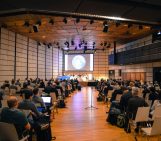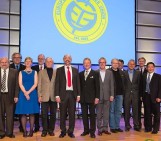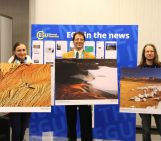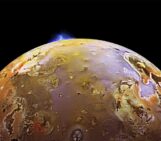
The conference is coming to a close and there’s still an abundance of great sessions to attend! Here’s our guide to getting the most out of the conference on its final day. Boost this information with features from EGU Today, the daily newsletter of the General Assembly – pick up a paper copy at the ACV entrance or download it here.
The final day of the conference kicks off with the last Union Session (US3) dedicated to discuss possible avenues of progress towards a commonly applicable framework for model building and application. Talks begin at 08:30 in Room B.
If you’ve been inspired to take a more active role in the organisation of the conference, why not head to the short course: How to convene a session at EGU 2017, starting at 10:30 in Room -2.85
Be sure to attend today’s Alexander von Humboldt Medal Lecture by Jean W.A. Poesen, who will be questioning whether research on soil erosion hazard and mitigation in the Global South is still needed (ML1: 12:15–13:15 / Room E1).
The final Great Debate of the week will address on of the biggest questions in the geosciences: Did plate tectonics start in the PaleoArchean? With conflicting schools of thought, it promises to be a lively and informative debate. Be sure to go along and share your thoughts on social media using the hashtag #EGU16GDB! (GDB5: 13:30 -15:00 /Room G1)
It’s your last chance to make the most of the networking opportunities at the General Assembly, so get on down to the poster halls and strike up a conversation. If you’re in the queue for coffee, find out what the person ahead is investigating – you never know when you might start building the next exciting collaboration! Here are some of today’s scientific highlights:
- Communication and Education in Geoscience: Practice, Research and Reflection; (EOS4: Orals, 08:30–12:00 / Room -2.16; Posters, 17:30–19:00)
- Origin of life and habitability: From Early Earth to the Solar System and Beyond (including David Bates Medal Lecture) (PS7.1/BG8.2: Orals, 08:30–12:15 and 13:30–15:15 / Room F1)
- Interactions between tectonics and surface processes from mountain belts to basins (IE3.1/TS3.1/GM4.5: 08:30–12:00 and 13:30–15:00 / Room K2, Posters: 17:30–19:00 / Hall X2)
- Aeolian dust: Initiator, Player, and Recorder of Environmental Change (AS3.4/CL4.13/GM11.4: Orals, 13:30–17:00 / Room F2; Posters, 17:30–19:00 / Hall X2)

‘Mirror Mirror in the sea…’ . Credit: Mario Hoppmann (distributed via imaggeo.egu.eu). A polar bear is testing the strength of thin sea ice. Polar bears and their interaction with the cryosphere are a prime example of how the biosphere is able to adapt to an “Active Planet”. They are also a prime example of how the anthropogenic influence on Earth’s climate system endangers other lifeforms.
Today we also announce the results of the EGU Photo Contest and the Communicate Your Science Video Competition. Head over to the EGU Booth at 12:15 to find out who the winners are.
What have you thought of the Assembly this week? Let us know at www.egu2016.eu/feedback and help make EGU 2017 even better.
We hope you’ve had a wonderful week and look forward to seeing you in 2017! Join us on this adventure in Vienna next year, 23-28 April 2017!





Hani
thats great, thanks
greeting from Afu University
http://goo.gl/tfeKBm